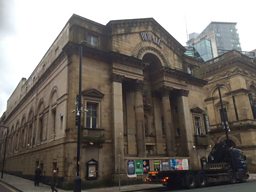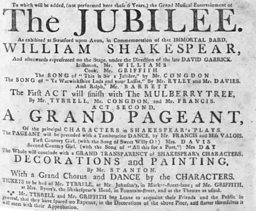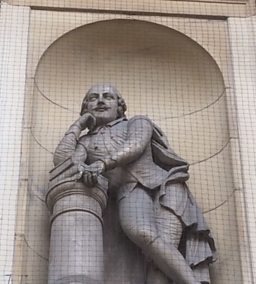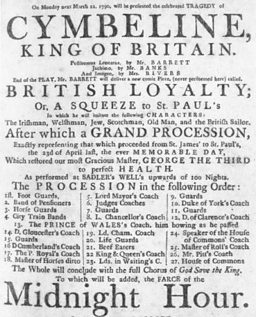Manchester gets a Theatre Royal
In a world in which the very act of theatre had to operate within tight government restrictions, Manchester finally got its own Theatre Royal by royal patent in 1775.
In fact it was among the early batch of cities to be given a royal licence to perform Shakespeare and other works outside of London. Before then, only London’s Drury Lane and Covent Garden theatres were officially licensed to operate – although over the years many a local magistrate had turned a blind eye to touring theatre companies performing in their area.
-
![]()
Much ado near me
Hear more Shakespeare stories on BBC Radio Manchester
-
![]()
Shakespeare Festival 2016
The BBC celebrates the genius of the bard

Manchester’s first permanent theatre, the Theatre Royal, was established in Spring Gardens but burned down four years later in 1779. It re-opened again in 1790, and continued until its lease expired in or around 1807. The licence then moved to a new building on Fountain Street where the Theatre Royal remained until 1844, when it burned down, again!
It was to be replaced by a new theatre on Peter Street which remained open until the 1920s, when it closed due to increasing competition from other theatres in the city.
The 1845 Theatre Royal still stands. It was originally dedicated to Shakespeare and still features prominently a statue of the Bard perched, somewhat forlornly, above the front entrance. There are reports it is being connected to a nearby hotel to create flats and apartments.
David Garrick devises Shakespeare Jubilee Festival
On stage at Manchester’s original Theatre Royal on March 12, 1787, was an evening’s entertainment which included elements of a famous pageant to Shakespeare.

It had been devised by the actor-manager David Garrick, about eighteen years before the show we see advertised in this 18th century playbill.
Garrick’s 1769 Festival was the first official commemoration of Shakespeare, and designed to celebrate 200 years since the Bard's birth (he was out by five years!).
Garrick’s original Festival was intended to run across three days, however heavy rain on day three caused flooding as the river Avon burst its banks and the performances in the specially erected rotunda had to be abandoned. The pageant was performed later at the Drury Lane theatre in 1769 and according to sources was a great success. Demand was so great that it was performed on 90 consecutive days.
“The Jubilee” was written by Garrick to capitalise on the popularity of his actual Jubilee. The two part afterpiece is enlivened by music, spectacle and the kind of humour which mocks stereotypes – naïve locals, exploited visitors, comic Irishmen, just the sort to appeal to a sophisticated audience(!).
This playbill, stored now by the British Library, guides people on where to buy tickets – not only from the theatre itself but also down at the Shakespeare’s Head in Fountain Street in Manchester from one of the theatre's managers, a Mr Griffith.

Cymbeline procession reflects the news of the day
This performance of Shakespeare’s Cymbeline (see playbill) in March 1790 comes at a significant moment both in the history of the Theatre Royal in Manchester and King George III.
Fear no more the heat o' the sun, Nor the furious winter's rages; Thou thy worldly task hast done, Home art gone and ta'en thy wages: Golden lads and girls all must, As chimney-sweepers, come to dust.Cymbeline (4.2.325)
The theatre has just re-opened having been destroyed by fire. While on stage, a new cast is putting on Cymbeline, about an ageing King of Britain tackling discontent at the heart of his court, and his family.
After the play there is a ‘Grand Procession’ enacted on stage, in which Shakespeare’s drama is linked to a real life event that could have triggered a constitutional catastrophe.
George III (1738 – 1820) had a recurring illness that caused him to withdraw from daily business. The king's doctors were unable to agree on either the cause or the cure of the illness. He became seriously ill in November 1788, some fearing madness.
His son, the Prince of Wales, wanted to be appointed regent, and to act as the king in everything but name. But he was very much associated with political opposition, and the government of the day was determined to keep him out.
Although there was much debate, the crisis abated when the king simply recovered.
This procession celebrates his restoration to health and marks the end of a period of uncertainty for the country.
Key protagonists in the real life drama feature in the parade such as the Prime Minister Pitt the Younger, and the Prince of Wales.
For the spectators, it’s a bit like the news being re-enacted before their eyes.
It also offers reassurance that stability has returned once more. After a rousing chorus of God Save the King the audience can settle down to enjoy a comic farce.

About Shakespeare on Tour
From the moment they were written through to the present day, Shakespeare’s plays have continued to enthral and inspire audiences. They’ve been performed in venues big and small – including inns, private houses and emerging provincial theatres.

BBC English Regions is building a digital picture which tracks some of the many iconic moments across the country as we follow the ‘explosion’ in the performance of The Bard’s plays, from his own lifetime to recent times.
Drawing on fascinating new research from Records of Early English Drama (REED), plus the British Library's extensive collection of playbills, as well as expertise from De Montfort University and the Arts and Humanities Research Council, Shakespeare on Tour is a unique timeline of iconic moments of those performances, starting with his own troupe of actors, to highlights from more recent times. Listen out for stories on Shakespeare’s legacy on your BBC Local Radio station from Monday 21 March, 2016.
You never know - you might find evidence of Shakespeare’s footsteps close to home…
Craig Henderson, BBC English Regions
-
![]()
Shakespeare Lives
The nation’s greatest performing arts institutions mark 400 years since the Bard's death
Related Links
The full playbill


Shakespeare on Tour: Around Manchester
-
![]()
The Tempest adapted in Manchester
Turbulent times in the early 1800s as The Tempest hits Manchester
-
![]()
Child acting sensation Master Betty on stage in Manchester
Master Betty plays Macbeth in Manchester
-
![]()
Small Cheshire town attracts Shakespeare's players
Shakespeare's Players often visited Congleton
Shakespeare on Tour: Around the country
-
![]()
The 18th century impersonator who was 'the Jon Culshaw of his day'
The city gets its prestigious Theatre Royal
-
![]()
The Northampton Repertory Theatre
Pieces of history in Northampton
-
![]()
Drunken robbers threaten the leader of Shakespeare's players
As he collects admission money at the door!
-
![]()
Shakespeare's tragic heroes appear in Launceston
Size not everything as Shakespeare's tragic heroes appear in remote town of Launceston










